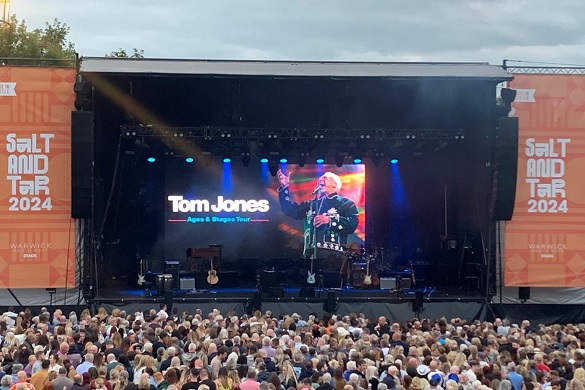An innovative digital project, led by the University of Liverpool, has conducted the first trial of new technologies that aims to address the issue of poor digital connectivity in busy settings.
The Liverpool LCR HDD project is using Open RAN technology in a private network, an emerging telecommunications network architecture that has been shown to enable low-cost, power efficient and unobtrusive small cells to meet the demands of high-density areas.
The project has just trialled its new Open RAN HDD private network at Salt and Tar's Music Festival. The four-day Festival attracted over 11,000 fans to Bootle's new outdoor venue to enjoy performances by the legendary Sir Tom Jones, Status Quo, the Red Rum Club and the Farm.
The event provided a real-world, high-density usage environment for the Liverpool LCR HDD project to test if the technology could deliver high capacity, open Wi-Fi to support e-ticketing and drink and food s ales in a secure, fast and efficient way to improve the user experience.
Further trials of the technology will take place across the region at both music, transport and sports venues to see how the new HDD network works in a range of venues that involve a high number of users in the same environment.
Professor Joe Spencer, from the University of Liverpool's Department of Electrical Engineering & Electronics, who is leading the Liverpool City Region HDD project, said: "I am delighted that the project has conducted its first trial in a real-world setting. This has been a real team effort involving excellent project management and partner participation and buy in".
"Using this new technology in this type of setting is innovative and ambitious project. This trial will provide us with data that we can analyse to assess the different components of the technology to see if it exceeds the performance of current and traditional technology solutions.
"We will learn more and more about the technology with every trial we conduct and I want to thank project partners and Salt and Tar for their support."
Further trials of the technology will take place across the region at both music, transport and sports venues to see how the new HDD network works in a range of venues that involve a high number of users in the same environment.
Ann Williams, Programme Director, Liverpool5G, said: "This was LCR HDD's first trial of Open RAN 5G SA service in a real-world high-density environment. We successfully provided connectivity for point-of-sale terminals via 5G MiFis and some public internet access using a very high capacity WiFi AP with 5G back-haul to the on-site network. In addition, we tested the 'Group QR code' eSIMs.
"We were able to demonstrate end-to-end functionality of the Open RAN 5G SA network and we will use the technical insights and data analysis gained from this event as we carry out further trials in the forthcoming months."
Councillor Paulette Lappin, Sefton Council's Cabinet Member for Economy, Regeneration and Skills, said: "I am delighted that our Salt and Tar venue in Bootle was able to support this innovative trial at our recent Music Weekender, which was attended by over 11,000 music lovers from across the world.
"We want to enhance the already great experience for our audiences and our traders at Salt and Tar events and look forward to seeing the benefits of the Liverpool HDD in the future."
Councillor Liam Robinson, Liverpool City Region Combined Authority Cabinet Member for Innovation, said: "It was brilliant to see the trial get under way at Salt and Tar's recent Music Festival. Testing this innovative technology in a real-life setting is an important milestone for the project and a key part of establishing how effective the technology can be in improving connectivity at large events to improve the experience for those attending.
"We will use the lessons learnt and data analysis from this event as we roll out trials in different types of venues in the forthcoming months."
The Liverpool City Region HDD consortium is led by the University of Liverpool in collaboration with the Liverpool City Region Combined Authority (LCRCA) and ITS Technology Group.
Partners include Liverpool John Moores University, local telecommunications, software and super-computing organisations: ITS Technology, Aro, CGA Simulation, the Science and Technology Facilities Council (STFC) Hartree Centre; and wireless tech. leaders from the UK and beyond Attocore, Weaver Labs, Telet, Radisys and Qualcomm
Further trials of the technology will take place across the region at both music, transport and sports venues. The consortium is already working on innovative networks at two venues in the region with plans for at least two more in development.
The Liverpool High Demand Density (Liverpool City Region HDD) is supported with a £9 million investment by the Department of Science, Innovation and Technology.
It was funded through DSIT's Open Networks Ecosystem (ONE) competition which aims to demonstrate the feasibility and reliability of technology.







